Adobo chicken is a traditional Filipino dish where chicken is marinated in a mixture of vinegar and soy sauce. It is then simmered in the same sauce, resulting in a flavourful meal with a unique balance of tanginess and sweetness.
I prepared a specific regional version of Filipino Adobo Chicken as traditionally done in the regions of Batangas and Laguna. Here they use a combination of turmeric and annatto seeds to give the dish both vibrant colour and flavour.
Recipe Story
Adobo carries a historical legacy that intertwines with Spanish colonial influence. The word “adobo” originates from the Spanish term “adobar,” which signifies the act of marinating and seasoning. Originally, Adobo served as a method of preservation. By combining meat with vinegar and spices it endured the tropical climate without the need for refrigeration. This technique allowed people to prepare large batches of food, ensuring it remained safe to consume for extended periods in a region where refrigeration was not readily available.
Adobo is a versatile dish that can be prepared with chicken, pork, or a combination of both. Traditionally served with rice.
Essential Ingredients
At the heart of Adobo’s rich flavour are a few key factors: the choice of meat, usually chicken or pork, but adaptable, and the essential combination of vinegar and soy sauce. They not only influence the taste but also play a critical role in the chemistry of the dish, leading to its distinctive and profound flavour profile.
- chicken – it’s crucial to incorporate a variety of chicken cuts. This means including thighs, drumsticks, and breast meat in the mix. This assortment of cuts contributes to a more satisfying combination of textures and flavours.
- vinegar – this is the most important ingredient, it brings a tangy vibrancy to the dish, infusing it with a zesty kick
- soya sauce – adds depth and savouriness, creating a robust flavour profile. It provides saltiness, which helps balance the acidity of the vinegar and the sweetness of any added sugar, creating a harmonious blend of flavours.
- garlic – infuses Adobo with its aromatic essence but also contributes a rich complexity to the taste.
Flavour Boosters
- vinegar
- soy sauce
- brown sugar
Vinegar, soy sauce, and brown sugar constitute the central flavour components of Adobo. This interaction, combined with the heat, leads to the breakdown of the meat’s collagen and the development of a savoury, umami-rich sauce. Brown sugar provides a delicate sweetness that balances out the acidity and saltiness of the vinegar and soy sauce. Over time, the reduction of liquid content creates a thicker consistency in the sauce. The result is a harmonious and concentrated mixture with a satisfying stickiness, characterizing the unique texture and flavour profile of Adobo.
Cooking & Tips
Preparation: You have the flexibility to prepare chicken meat in different ways. It can be cut into small cubes or chunks or leave it as whole pieces like wings, drumsticks, or thighs. I’ve personally prepared Adobo with all these methods to enjoy the unique textures and flavours each brings to the dish.
Marinade: In some Adobo variations, the marinating step is omitted, and all the ingredients go into a single pot for immediate cooking. In my personal preference, marinade is important for Adobo’s full development of flavours. I recommend marinating for a minimum of two hours. I often choose to extend this process, allowing the meat to marinate overnight. This extended marination period not only enhances the taste but also results in a very tender and succulent meat.
Cooking: If you opt for a no-marination approach, here’s an alternative method: Begin by finely chopping onions and sautéing them in hot oil in a deep pot until they achieve a golden hue. Subsequently, add the chicken pieces, allowing them to acquire a golden sear on all sides after a few minutes. At this point, introduce all the liquid components along with the remaining ingredients, ensuring thorough mixing, and then allow the mixture to simmer over medium heat
The versatility of Adobo Chicken extends to the consistency of its sauce. It can range from thin and fluid to thick and sticky, depending on liquid reduction post-cooking. I prefer a thicker sauce, as seen on the photos. If you intend to pair Adobo with potatoes or bread, I recommend maintaining a more liquid texture. This is to ensure an ideal complement to these accompaniments. I simmered it until it became as thick as syrup!
Ingredient Substitutions & Additions
- chicken – Chicken in Adobo can be substituted with pork, a popular alternative, or various other meat options, allowing for a diverse and versatile range of flavours
- vinegar – In traditional Adobo recipes, cane vinegar is often the vinegar of choice. However, apple cider vinegar serves as a perfect substitute. Its slightly sweet and fruity notes complement the flavours of Adobo exceptionally well.
- garlic – Its pungent and aromatic qualities are integral to the dish’s flavour profile, making it a non-negotiable ingredient for an authentic Adobo experience.
- annatto seeds – While they can be occasionally hard to source in the West, you can effectively substitute them with sweet paprika (non-hot and non-smoky) for a similar visual impact. For those inclined to explore, this provides an opportunity to experiment with various spices and seasonings, allowing for a touch of personal creativity in your Adobo recipe
Adobo is not only delicious but also highly adaptable to personal preferences. For those who relish a spicy kick, adding elements like chili flakes, fresh chili peppers, or cayenne powder can infuse a fiery note into the dish.
Ginger, with its aromatic warmth, can be introduced for an extra layer of flavour. And for those who appreciate a dash of umami, a drizzle of fish sauce can elevate the savoury profile.
If you’re aiming for an exceptionally rich sauce, consider including a finely sliced onion. This can be sautéed at the beginning of the cooking process for a caramelized depth of taste or added along with all the other ingredients for a milder, sweeter note. These customizable touches allow you to tailor your Adobo to your personal taste, making each batch a unique culinary adventure.
Serving & Presentation
Adobo Chicken is typically accompanied by steamed white rice. Garnish your Adobo with a handful of fresh cilantro or parsley, or as I often prefer finely chopped fresh chives. This touch of vibrant green adds a visual appeal but also imparts a burst of freshness to the dish.
The thick and savoury Adobo sauce is generously spooned over the chicken and rice and is integral to the meal. Adobo is often served family-style, encouraging communal sharing, and depending on preferences and regional variations, it may be accompanied by side dishes such as vegetables, pickled papaya (atchara), or even a fried egg.
I usually serve Adobo with potatoes or rice.
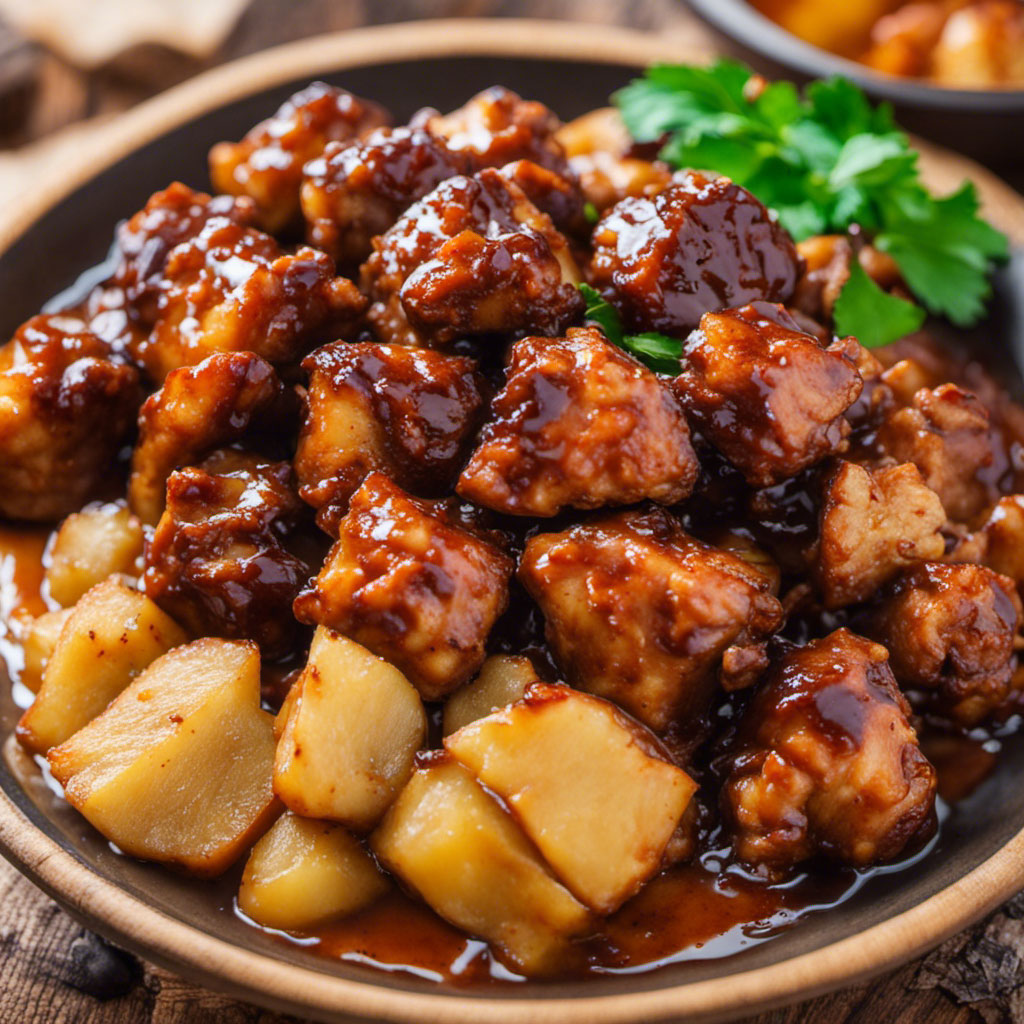
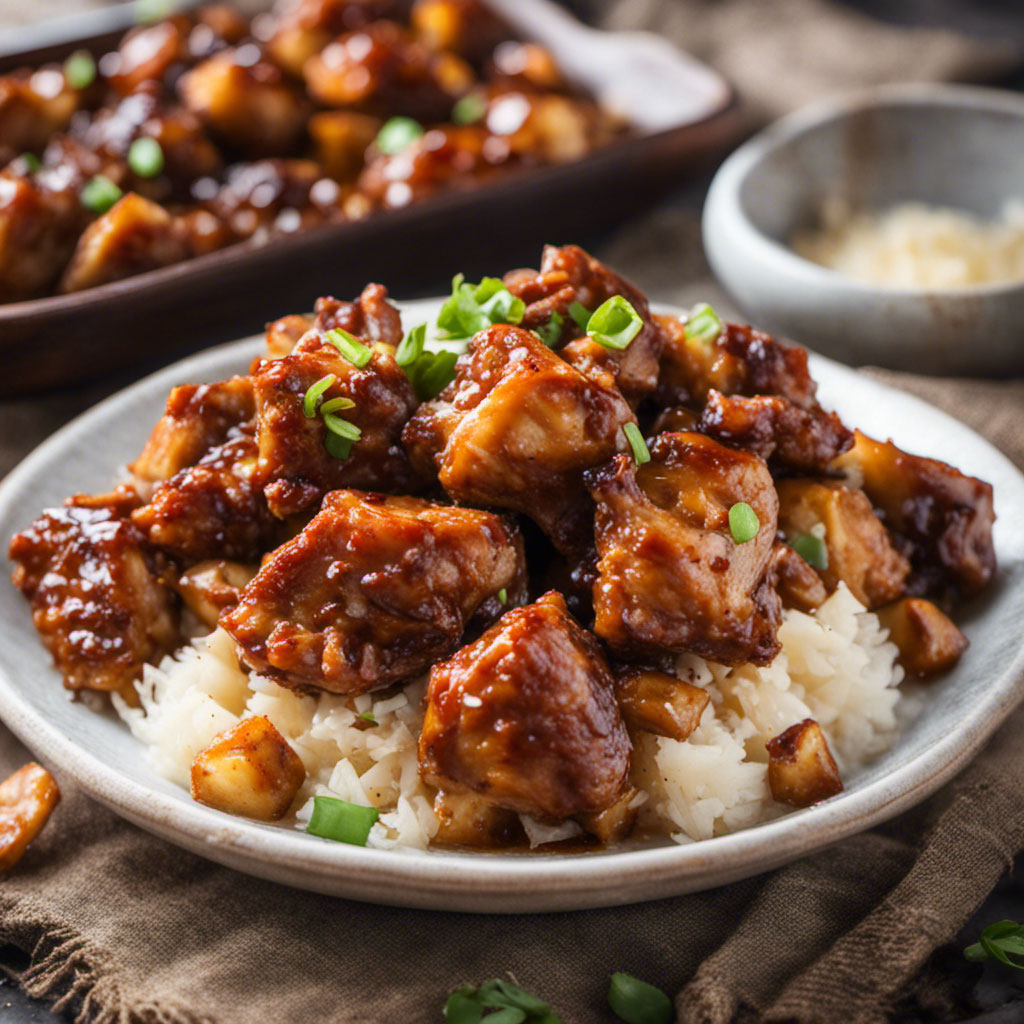
Why not elevate your dining experience by serving Adobo on banana leaves, reminiscent of the serene beaches of the Philippines? 🙂 Alternatively, for a comforting and substantial meal, you can opt for whole pieces of chicken meat.
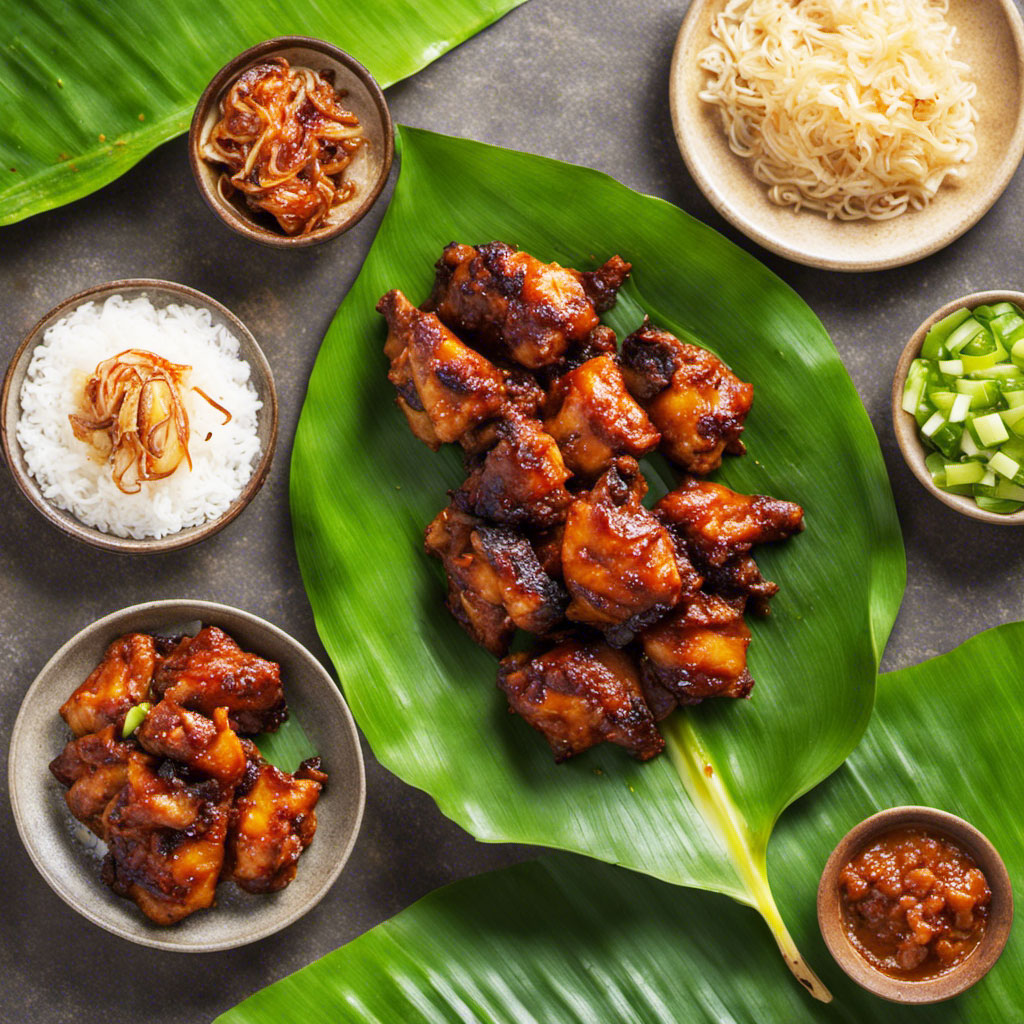
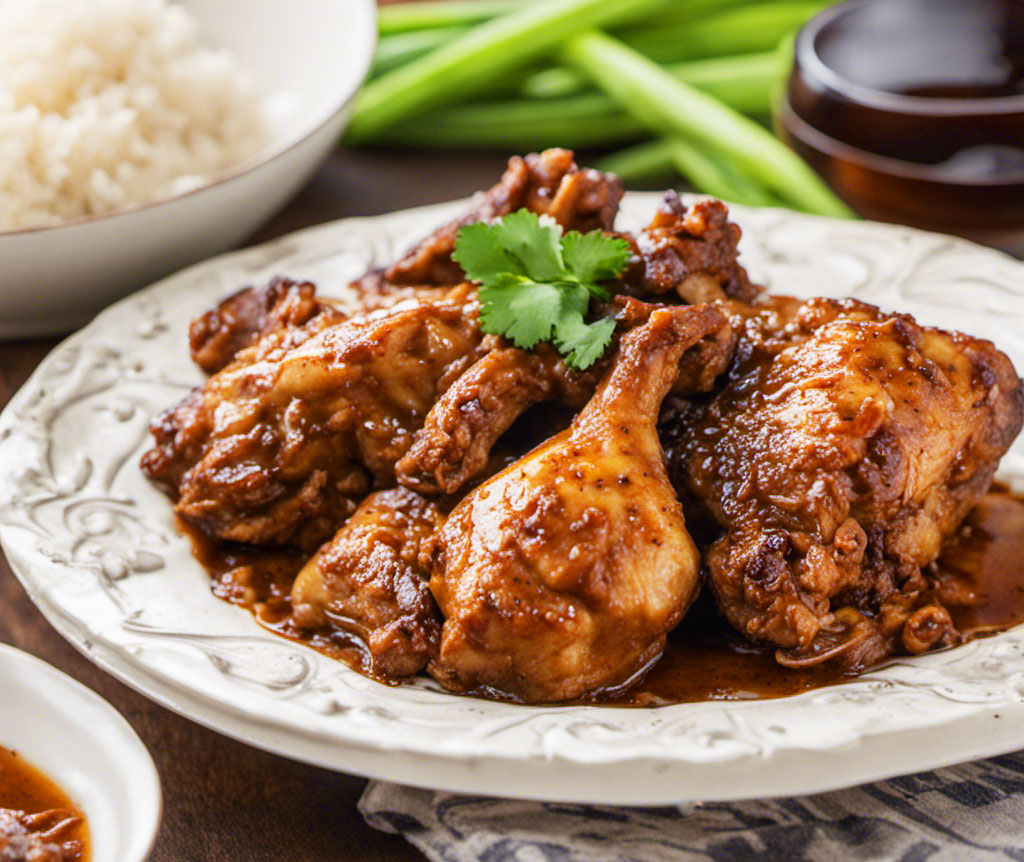
This classic Filipino dish is a comforting and satisfying favourite, often relished in the company of family and friends. Its simplicity and robust flavours make it a staple in Filipino homes and gatherings, fostering a sense of togetherness and warmth.
Recipe Card
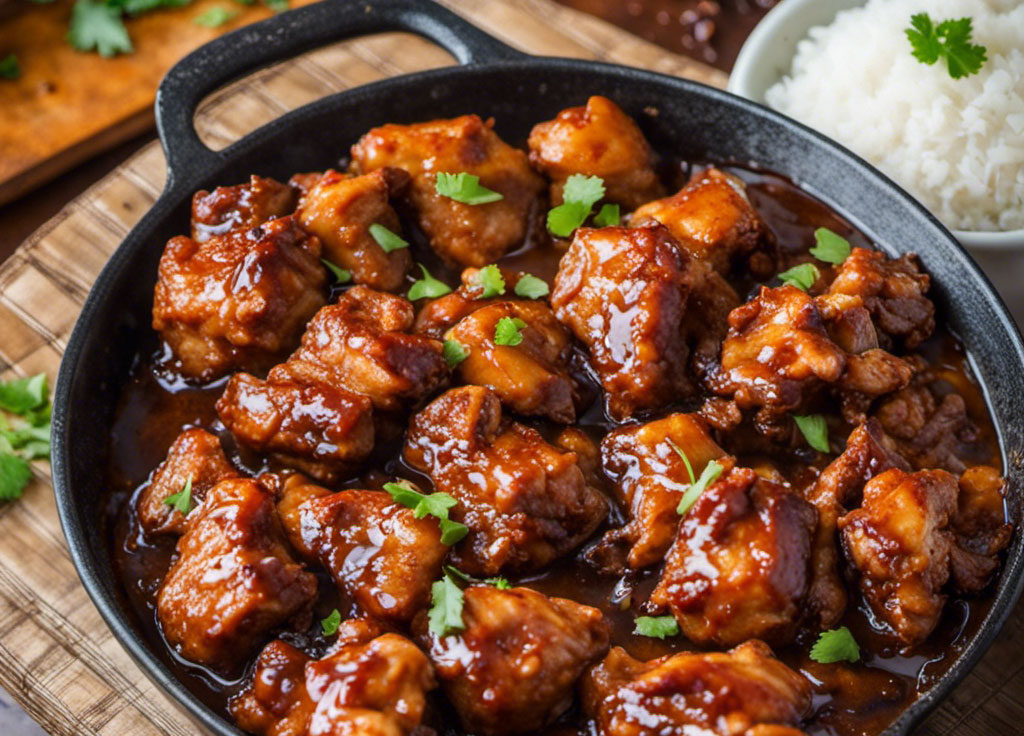
Adobo Chicken (Adobong Manok) Recipe: Authentic Taste of the Philippines
Ingredients
- 800 g assorted chicken pieces - mix of thigh fillets and breast
Marinade
- 5 cloves garlic
- 200 ml apple cider vinegar
- 375 ml chicken stock
- 3-4 bay leaf
- 1 tbsp cracked black peppercorns
- 2-3 tbsp soy sauce
Other
- 2 tsp annatto seeds - or 1 tsp of turmeric + paprika
- 1 tbsp brown sugar
- 2 tbsp oil
Instructions
- In a bowl, prepare the marinade: Mix finely chopped garlic, vinegar, chicken stock, bay leaf, black pepper, annatto seeds (or the substitute), and soy sauce. Mix well.
- Prepare the chicken by cutting it into small pieces or leaving it in larger chunks, or you can choose to keep the chicken thigh, drumstick, or chicken breast in individual pieces according to your preference. Pat dry with kitchen towel. Pour the marinade over chicken meat. Mix, cover and let it marinade in the fridge for at least 2 hours.
- Put chicken together with the marinade in a deep pot. Let it boil, then cover it, reduce the heat, and cook the chicken for half an hour. After half an hour, uncover it and continue cooking for another 10 minutes until the chicken is fully cooked.
- Remove the chicken pieces and set them aside. Continue cooking sauce for another 10 minutes over high heat until the liquid reduces by half. ( or less if you prefer slightly liquidy sauce.
- Heat oil in a pan or wok, add the chicken, and fry it for five minutes on each side until it becomes crispy and brown.
- Arrange the chicken on a serving plate and pour the sauce over it. Sprinkle with chopped parsley.
